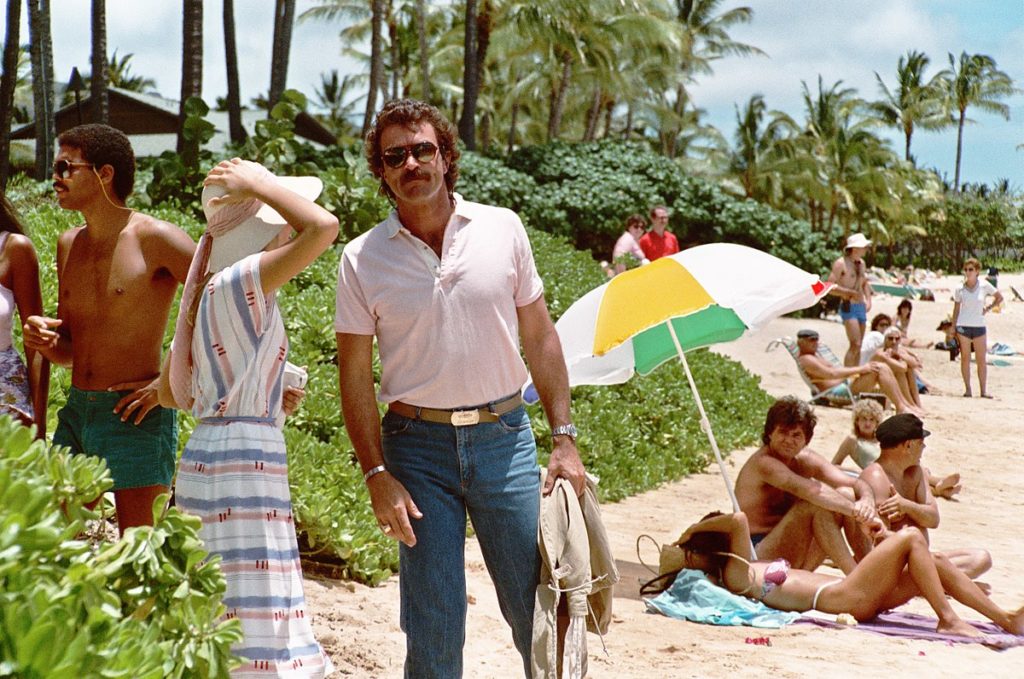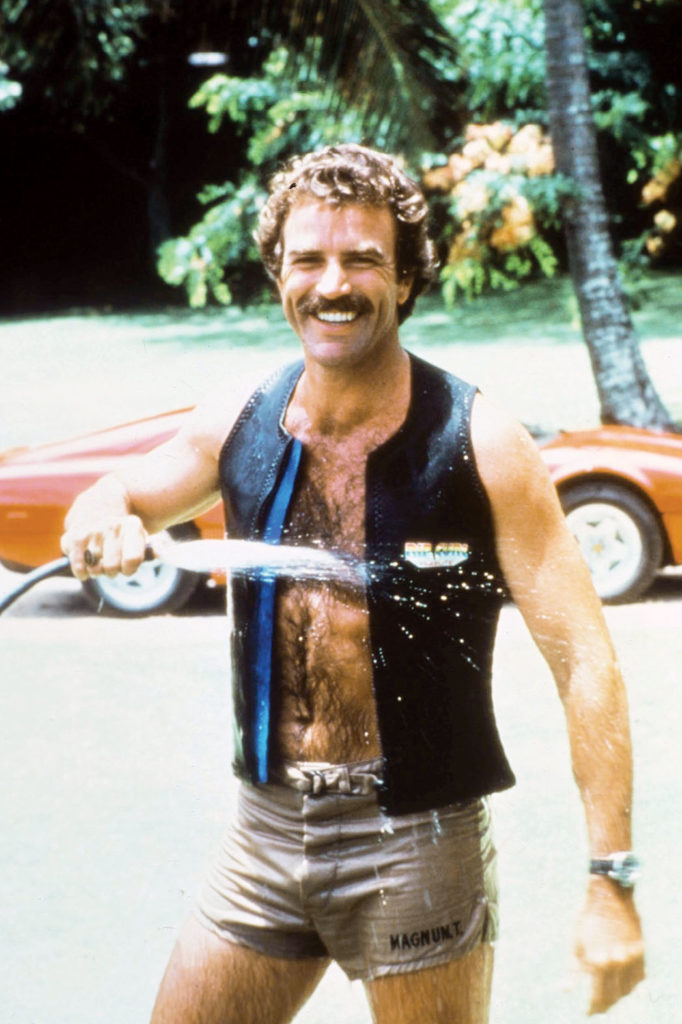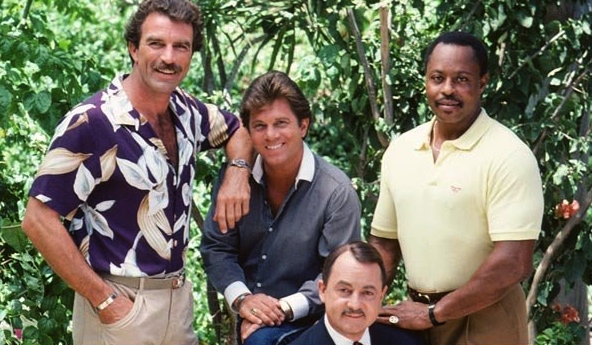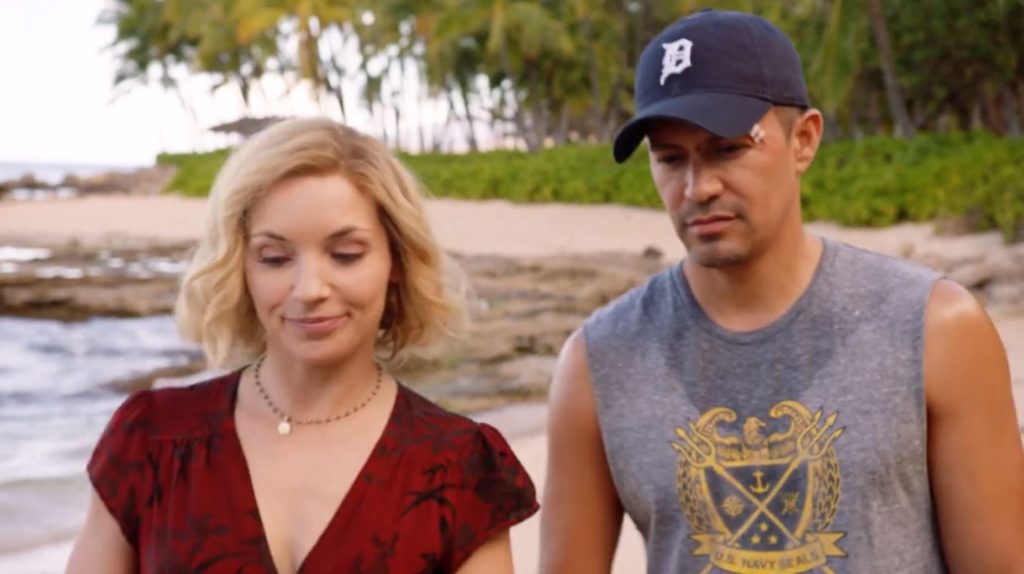The Ferrari. The Hawaiian shirts. The short-short shorts.
The mustache!
For eight TV seasons, “Magnum, P.I.” offered the world a glimpse into paradise—admittedly, the paradise of a 1980s private eye living rent-free at a gorgeous Hawaiian estate. Thomas Magnum, a Vietnam veteran, was head of security for Robin’s Nest, the home of an elusive writer of bestselling thrillers.
The series made Tom Selleck a star, and deservedly so. Selleck could play both the charming overgrown adolescent and daring action hero without even changing tropical print shirts.
For the past two seasons, the CBS reboot of the Selleck series has struck many of the same notes: a White Knight hero with a military background, surrounded by war buddies, serving at the whim of Robin Masters and butting heads with Higgins, Robin’s proper Brit majordomo with little tolerance for Magnum’s shenanigans. This time, however, Selleck’s deck shoes are filled by Jay Hernandez and Higgins isn’t played by the pitch-perfect, supercilious John Hillerman but by Perdita Weeks. It is a gender-reversal that’s delightful in part because Weeks’ Higgins is the real kickass action star of the new series.
The reboot cuts short the credits and the rockin’ theme by Mike Post and Pete Carpenter, and Hernandez hasn’t so far attempted a Selleck-style ‘stache. (There is a little razor-stubble goatee going on.) The new series greatly increases the diversity quotient, appropriate for a story set in the Pacific Ocean crossroads of the globe.
But there’s no shame in the game of the Selleck-infused original. Here’s a look at some of the strong suits of the shows and the classic TV private detective character

Hawaii Island James Bond with Machine Guns?
The story of “Magnum, P.I.” really begins in 1968 with the debut of “Hawaii Five-O,” a CBS series set and, untypically for television, filmed in Hawaii, which the history books remind us had become the nation’s 50th state just nine years earlier.
“Five-O” featured Jack Lord, an actor with a stiff pompadour and a sense of humor to match, as the head of the island’s state police force. Besides one of TV’s great theme songs (“Five-O’s” was written by Morton Stevens), the lead’s service in the Navy, exotic locales and undertones of espionage and global threat uncommon to most TV cop dramas, “Five-O” shared with its successor “Magnum, P.I.” production qualities that appealed to CBS and its viewers. The series’ exotic nature felt real because it was real, thanks to the location shooting. Producing a Hawaii-set show in the Los Angeles area, like ABC had from 1959 to 1963 with the private eye drama “Hawaiian Eye,” was no longer acceptable to viewers.
“Hawaii Five-O” ended in 1980, after 12 seasons and 279 episodes, leaving a void for Hawaii-produced shows that could take advantage of the production infrastructure that “Five-O” had established.
For a 2018 Medium article recapping an Archive of American Television interview with “Magnum, P.I.” producer Donald Bellisario noted that CBS wanted another Hawaii-based show to allow them to maintain the “extensive studio” built for “Five-O.” Finding a show for former cigarette advertisement star Tom Selleck was also something of a priority for Universal: Selleck had starred in six TV pilot films that went nowhere, but was still serving under the terms of a development deal with the studio. It was a deal that would come back to bite Selleck.
But producer Glen A. Larson, the man behind series of that period like “Battlestar: Galactica,” originally planned a very different Thomas Sullivan Magnum than the one viewers ultimately grew to know and love.
Bellisario was not pleased with the pilot script that Larson passed along to him. In the Medium article, Bellisario noted that the “Magnum” script was a “rip” on James Bond movies, with Magnum as a stalwart private eye living in a cliff-top estate with a ferocious dog and piloting a hang glider equipped with … machine guns.
Selleck, a household face thanks to the ads for Salem cigarettes and a handful of Western TV miniseries and movies, already had a good idea of the kind of series he wanted to do. He didn’t want to play an infallible hero.
“I just don’t want to play what I look like,” Selleck told Bellisario. He wanted to play a character that not only had a humorous side but also one that might mess up an investigation and have to battle his way back from failure.
Bellisario had previously worked on an idea for a series about a private eye named H.H. Flynn who lived in California, was the permanent house guest of a millionaire, drove the mogul’s Ferrari and was friends with two fellow Vietnam vets, Rick and T.C. Rick owned a bar and T.C. owned a helicopter he used to fly workers to oil rigs.
Bellisario, the Medium article noted, pitched the idea of combining his and Larson’s H.H. Flynn and Magnum concepts and setting the series in Hawaii. Larson later said he came up with the idea of making Magnum’s never-seen millionaire benefactor the author of thrillers, a concept that provided fertile plot material not only for the original “Magnum, P.I.” series but the 2018 reboot.
Integral to the series was the idea of making Magnum, T.C. and Rick veterans of the Vietnam War. From the late 1960s on, television series had portrayed Vietnam vets as tortured souls who were prone to breaking down and carrying out violent acts. In “King of the Hill,” a January 1969, first-season episode of “Hawaii Five-O,” the great Yaphet Kotto played a Marine and vet who barricades himself in a wing of a Honolulu hospital and, believing himself back in action, takes hostages.
But “Magnum P.I.” made its lead characters Vietnam Veterans who, while sometimes haunted by their time in service, were honorable, stable men. Over the life of the show, echoes of Vietnam were felt many times.
During the development of the pilot, Bellisario and Larson created a fourth character who would be essential to the show—with great variation in the 2018 reboot. John Hillerman joined Selleck, Larry Manetti (Rick) and Roger E. Mosley (T.C.) in the cast and played Higgins, the majordomo of Robin’s Nest, the beachfront estate owned by author Robin Masters. Higgins was frequently exasperated that his employer would allow Magnum to live in the estate’s guesthouse in return for performing security services and the occasional private eye duties.
Higgins’ initially condescending and even tormenting attitude toward Magnum softened somewhat over the years as the two (and Rick and T.C.) found common ground in their shared military past: Higgins was a lifelong British soldier, even joining the other three on missions (as we’ll see).
The first mission for “Magnum, P.I.” was to survive in the jungle of television.

Magnum Debuts and Thirstiness Ensues
“Magnum, P.I” debuted on CBS on December 11, 1980. For weeks before the show aired, U.S. newspapers—no doubt relying on wire service copy—repeatedly referred to the title character as a “fun-loving ex-Navy man” or “fun-loving private investigator.”
Newspaper coverage in the weeks leading up to the show was inane. There were the “Is ‘Magnum’ another ‘Hawaii Five-O?’ takes, of course, because the two shared a home and “Five-O” had run for 12 years, a TV eternity then and now.
Selleck had made something of a name for himself playing a perfect and perfectly oblivious private eye named Lance White in a couple of episodes of “The Rockford Files,” which proved not only his appeal but also his willingness to poke fun at his image. That added to the star’s profile.
By the time of the December 11 premiere, “Magnum, P.I.” was the last of the new fall shows to debut because of a Screen Actors Guild strike.
And the nation’s entertainment reporters were primed for Selleck.
In a December 7 story in the Akron (Ohio) Beacon Journal, the writer referred to Selleck as “beefcake.”
The newspaper coverage of Selleck that followed exhibited what the young people today would call “thirst.”
Almost every story, whether written by a male or female columnist, noted that Selleck was six-foot-four and chiseled. “Brawny” and ‘well muscled” were used in a Knight Ridder preview of the series.
In the Quad City Times newspaper, a writer began her coverage, “Tom Selleck, all 6’4” of him along with bushy mustache, deep dimples and handsome façade, was wide awake in the morning as he sunk down into the couch cushions to respond to questions about his first starring TV series, Magnum P.I.,” adding, “One wonders if even the title wasn’t tailored to this huge hulk of a man in blue jeans, a blue and white checked shirt, white tennis shoes sans socks, carrying a navy blazer. His proportions did a lot for the wardrobe. … His dimples and eyes crinkle and you can’t help but smile with him.”
For all its panting, the Quad City Times article had more in the way of news than many stories previewing “Magnum.” Selleck told the writer that the pilot had been shot in January of that year and he landed the series, in part, because of his contract with Universal, which he mistakenly thought had come to an end.
Selleck said the production company was shooting its first 13 episodes—a common number of episodes to produce until a network picks up a full season or even beyond—in 16 weeks and revealed that the emphasis on the characters’ Vietnam experiences would play into most episodes.
“Hawaii Five-O” star Jack Lord had called Selleck. “He was very nice,” Selleck said in the interview.
Other interviews confirmed that Magnum was originally intended to be a James Bond-style hero. “Now he’s capable but fallible,” the star said.
Selleck also noted that while Universal considered shooting on the mainland, a la “Hawaiian Eye,” CBS and Selleck had objected.
The CBS promotions for the series were … not subtle. An ad in the New York Daily News on December 11, 1980, the day the first episode aired, showed Selleck mugging and making an “OK” sign over copy that reads, “You’re gonna love Magnum! He’s a wisecracking, fun-loving, freeloading freelance private eye! He’s a hellraiser in paradise!
“He’s a good looking laidback charmer in a loud shirt who loves fast cars and slow blondes!” (Yeesh.)
At the bottom of the newspaper ad, in a whiplash-inducing change of tone, CBS notes: “Watch the CBS Evening News with Walter Cronkite at 7 p.m.”
The two-hour premiere of “Magnum, P.I.” aired opposite popular sitcoms like “Mork and Mindy,” “Bosom Buddies” and “Barney Miller.” It did well in the Nielsen ratings, ranking eighth for the week. The top show of the week was “Dallas.” “Magnum, P.I.” topped “Three’s Company” that week but scored below not only “Dallas” but “The Dukes of Hazzard” and “Circus of the Stars.”
More than 18 million people watched “Magnum P.I.” debut. Thanks to the decline of network television viewership over the decades, the 18 million viewers who made “Magnum” the eighth most popular show of its first week equaled the number who made “Sunday Night Football” the top show of the 2018 season.

All For One on the Big Island
We can all admit it: The most sophisticated network television series of the 1980s was not as sophisticated as many shows, network, cable and streaming, today. “Magnum, P.I.” was no exception to that 1980s standard.
Over eight seasons and 162 episodes, Selleck and executive producers Bellisario and Larson turned out dependable and entertaining TV action fare leavened with humor, gorgeous scenery and a fun cast led by an actor whose appeal was off the charts.
The chemistry among the main players, aided and abetted by recurring performers and guest stars, was palpable.
Mosley and Selleck had shared a credit before, appearing in small roles in a 1973 tropical island prison action flick, “Terminal Island.” Other than the steamy setting, the movie didn’t serve as much of a training ground for “Magnum.”
The bond among the three Vietnam vets—who bickered and kidded throughout the series—was a strong point, but the relationship between Selleck and Hillerman as Magnum and Higgins saw the most growth over the years. Higgins went from sic’ing Robin’s guard dogs, Zeus and Apollo, on Magnum to lending his expertise (and, often unwillingly, his cameras and other equipment) to the private eye.
Notably, in the season five two-part episode “All for One,” Higgins—older and sedentary by his own admission but an experienced ex-British agent and soldier—accompanies Magnum, T.C. and Rick to Cambodia. They’ve gone at the request of an old comrade, played by Robert Forster, to rescue a mutual friend who was left behind on a recent mission.
For all the comic blustering and arguing among the four core characters throughout the series, “Magnum, P.I.” regularly delivered sober action drama, and much of it grew out of the wartime experiences of the leads.
There’s no better example than “Did You See the Sunrise?,” a two-part episode written by Bellisario from the third season. Using a character who would be revived for the 2018 reboot, the episodes introduced Ivan, a Soviet officer who had tortured Magnum, T.C. and Rick in a prisoner of war camp in Vietnam. As played by Bo Svenson, Ivan is a truly frightening and remorseless killer.
The final moments of the episode play out in a shocking fashion, as Selleck, unable to bring Ivan to justice, acts in a manner not often seen with weekly TV heroes of the time: He executes Ivan in cold blood.
(Magnum himself would die before the series played out … but he was only a little bit dead, in a story devised by the producers before it was determined that the show would return for one more season.)
The series usually stuck to the conventions of weekly TV at the time, in an era long before today’s serial storytelling and characters that break bad, but still managed to bring some depth to the characters and their relationships.
And it featured, aside from the regular and recurring cast, an impressive array of guest stars and stars-to-be, including Carol Channing, Ted Danson, Patrick MacNee (as an old colleague of Higgins who believes he is Sherlock Holmes), Dana Delaney, Clyde Kusatsu, Robert Loggia, John Saxon, Sharon Stone, Dennis Weaver and, perhaps most notably, Angela Lansbury and Frank Sinatra.
Lansbury played her “Murder, She Wrote” character, Jessica Fletcher, in a CBS-inspired crossover, while Sinatra appeared in his last major acting role in “Laura,” a season seven episode in which the superstar singer and actor played a New York cop who pursued a killer to Hawaii.
Selleck recalled years later that Larry Manetti (Rick) had told him that Sinatra was a fan and wanted to appear on the show. Sinatra played the kind of tough guy he played in 1960s cop movies and, although he initially waived his fee, Selleck said in a 2016 TV interview that Sinatra’s expenses for coming to Hawaii to film amounted to a cool $250,000.
The series made Selleck a star, but he’s acknowledged in interviews that doing “Magnum” caused him to miss out on another great role: Indiana Jones. Selleck has said Steven Spielberg and George Lucas had offered him the lead in “Raiders of the Lost Ark,” but “Magnum, P.I.” production company Universal wouldn’t allow him to take the role, fearing a clash of shooting schedules. As it turned out, Selleck noted, he could have done both, presumably due to the delay in filing the original 1980 pilot of the series due to the Screen Actors Guild strike. But it was not to be, and Harrison Ford played Indiana Jones. Selleck’s turn as Indy survives only in a screen test available online.
The series holds up for viewing more than two decades after it last aired and rediscovering its pleasures—the cast, the settings, the camaraderie and plot points like the elusive Robin Masters, who was voiced in a few episodes by screen giant Orson Welles—is a good way to spend a weekend.
(Welles’ voice-only “appearances” were put into an unexpected context in that 2018 interview with Bellisario. “I thought it would be great to Orson Welles’ voice,” he recalled. “And Orson would do anything for money at that point. There’s a sad story.”)

“Magnum”—the Next Generation
The 2018 “Magnum P.I.”—minus the comma of the original—retained many of the plot elements and most of the characters of the original series as well as many of the series’ touchstones: Magnum’s Detroit Tigers baseball cap, the red Ferrari, Robin’s Nest, guard dogs Zeus and Apollo and, most importantly, the relationships among the lead characters.
The new “Magnum P.I.”—apparently renewed for a third season, although when production will begin is uncertain due to the pandemic—improved on the original in some ways. As Magnum, Jay Fernandez is a charismatic performer who can handle the dramatic and light-hearted moments of the new series. He’s not the eyebrow-waggling equal of Selleck, but he’s an interesting persona, much better suited to stardom here than in his unrecognizable turn in the movie “Suicide Squad.”
Hernandez is a fourth-generation Mexican-American talent, and while he probably wasn’t cast to bring a note of diversity to the leading role of the series, the new show’s cast better reflects the Hawaiian melting pot culture, with actors including Zachary Knighton, Steven Hill, Amy Hill, Tim Kang and Taylor Willy.
Perhaps the biggest other change is that Jonathan Higgins is now Juliet Higgins and is played by Perdita Weeks. She is British—unlike Hillerman, a Texas native who perfected the right mid-Atlantic/British tone—and plays an updated, more espionage-oriented character. Juliet Higgins is a veteran British secret agent who uses her connections and technical savvy to help Magnum on cases.
It’s also a help that as played by the appealing Weeks, the new Higgins, while initially antagonistic toward Magnum and protective of her boss, Robin Masters, became an integral part of the stories and the action.
Indeed, Higgins is arguably the most skilled badass among the characters, equally adept with her fists or a gun. Higgins is often the first to burst into a dangerous setting or run a bad guy to ground, and Weeks (and the stunt team, I’m sure) completely sells this.
Higgins’ experience and capability mean that she fits in well with Hernandez, Knighton (as Rick) and Stephen Hill (as T.C.) on missions that dovetail with their military and intelligence backgrounds.
And the mystery of Robin Masters and his work that was a thread of the original series continues in the reboot, including one episode in which terrorists take over Robin’s Nest to try to find Masters’ notes revealing who the “White Knight” from his novels is based on.
No doubt that some viewers will find the new “Magnum P.I.” suffers in comparison to the original series. The original cast will always be those characters in the minds and hearts of many who appreciated the show. But the reboot offers much of what made the original so good: an appealing cast in good action scenes among lush settings.
And perhaps best of all, Thomas Magnum and his compatriots live for a new generation of viewers.

















